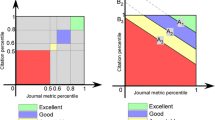Abstract
In a bibliometric study of nine research departments in the field of biotechnology and molecular biology, indicators of research capacity, output and productivity were calculated, taking into account the researchers' participation in scientific collaboration as expressed in co-publications. In a quantitative approach, rankings of departments based on a number of different research performance indicators were compared with one another. The results were discussed with members from all nine departments involved. Two publication strategies were identified, denoted as a quantity of publication and a quality of publication strategy, and two strategies with respect to scientific collaboration were outlined, one focusing on multi-lateral and a second on bi-lateral collaborations. Our findings suggest that rankings of departments may be influenced by specific publication and management strategies, which in turn may depend upon the phase of development of the departments or their personnel structure. As a consequence, differences in rankings cannot be interpreted merely in terms of quality or significance of research. It is suggested that the problem of assigning papers resulting from multi-lateral collaboration to the contributing research groups has not yet been solved properly, and that more research is needed into the influence of a department's state of development and personnel structure upon the values of bibliometric indicators. A possible implication at the science policy level is that different requirements should hold for departments of different age or personnel structure.
Similar content being viewed by others

References
Braun, T., W. GlÄnzel, A. Schubert, (1985), Scientometric indicators. A 32-country comparative evaluation of publishing performance and citation impact, World Scientific, Singapore.
Burrell, Q., R. Rousseau (1995), Fractional counts for authorship attribution: a numerical study. Journal of the American Society for Information Science, 46: 97-102.
De Lange, C., W. GlÄnzel (1997), Modelling and measuring multilateral co-authorship in international scientific collaboration. Part I. Development of a new model using a series expansion approach, Scientometrics, 40: 593-604.
Garfield, E. (1979), Citation Indexing — Its Theory and Applications in Science, Technology and Humanities, New York: Wiley.
Hagstrom, W. O. (1965), The Scientific Community, New York: Basic Books.
Harsanyi, M. A. (1993), Multiple authors, multiple problems — Bibliometrics and the study of scholarly collaboration: A literature review, Library and Information Science Research, 15: 325-354.
Herbertz, H. (1995), Does it pay to cooperate? A bibliometric case study in molecular biology, Scienometrics, 33: 117-122.
Herbertz, H., B. MÜller-Hill (1995), Quality and efficiency of basic research in molecular biology: A bibliometric analysis of thirteen excellent research institutes, Research Policy, 24: 959-979.
Ingwersen, P., I. Wormell (1999), Publication behaviour and international impact: Scandinavian clinical and social medicine 1988–96. In: Macias-Chapula, C. A. (Ed.), Proceedings of the 7th Conference of the International Society for Scientometrics and Informetrics, Colima, México, July 5–8, 1999, Colima (México), Universidad de Colima, 222-233.
Katz, J. S., D. Hicks (1997), How much is a collaboration worth? A calibrated bibliometric model, Scientometrics, 40: 541-554.
Martin, B. R., J. Irvine (1983), Assessing basic research. Some partial indicators of scientific progress in radio astronomy, Research Policy, 12: 61-90.
Moed, H. F., R. E. De Bruin, Th. N. Van Leeuwen (1995), New bibliometric tools for the assessment of national research performance, Scientometrics, 33: 381-422.
Moed, H. F. (1998). A Bibliometric Study of the Departments Included in the Flanders Inter-University Institute for Biotechnology (VIB). Leiden: Centre for Science and Technology Studies, Leiden University, CWTS Report 98-09, 54.
Narin, F. (1976), Evaluative Bibliometrics. The Use of Publication and Citation Data in the Evaluation of Scientific Activity. National Science Foundation, Washington DC, USA.
Narin, F., K. Stevens, E. S. Whitlow (1991), Scientific cooperation in Europe and the citation of multinationally authored papers, Scientometrics, 21: 313-323.
Rinia, E. J., C. De Lange, H. F. Moed (1993), Measuring national output in physics: Delimitation problems, Scientometrics, 28: 89-110.
Schubert, A., Braun, T. (1985), Relative indicators and relational charts for comparative assessment of publication output and citation impact, Scientometrics, 9: 281.
Schubert, A., W. GlÄnzel, T. Braun (1989), Scientometric Datafiles. A comprehensive set of indicators on 2649 journals and 96 countries in all major science fields and subfields 1981–1985, Scientometrics, 16: 3-478.
Van Den Berghe, H. R. E. De Bruin, J. A. Houben, A. Kint, M. Luwel, E. Spruyt, H. F. Moed (1998), Bibliometric indicators of university research performance in Flanders, Journal of the American Society for Information Science, 49: 59-67.
Van Raan, A. F. J. (1996), Advanced bibliometric methods as quantitative core of peer review based evaluation and foresight excercises, Scientometrics, 36: 397-420.
Van Raan, A. F. J. (1998), The influence of international collaboration on the impact of research results, Scientometrics, 42: 423-428.
Vinkler, P. (1986), Evaluations of some methods for the relative assessment of scientific publications, Scientometrics, 10: 157-178.
Vinkler, P. (1991), Magic triangle for three relative impact indicators, Scientometrics, 21: 143-146.
Zuckerman, H. (1968), Patterns of name-ordering among authors of scientific papers: A study of social symbolism and its ambiguity, American Journal of Sociology, 74: 276-291.
Author information
Authors and Affiliations
Rights and permissions
About this article
Cite this article
Moed, H.F. Bibliometric Indicators Reflect Publication and Management Strategies. Scientometrics 47, 323–346 (2000). https://doi.org/10.1023/A:1005695111622
Issue Date:
DOI: https://doi.org/10.1023/A:1005695111622



